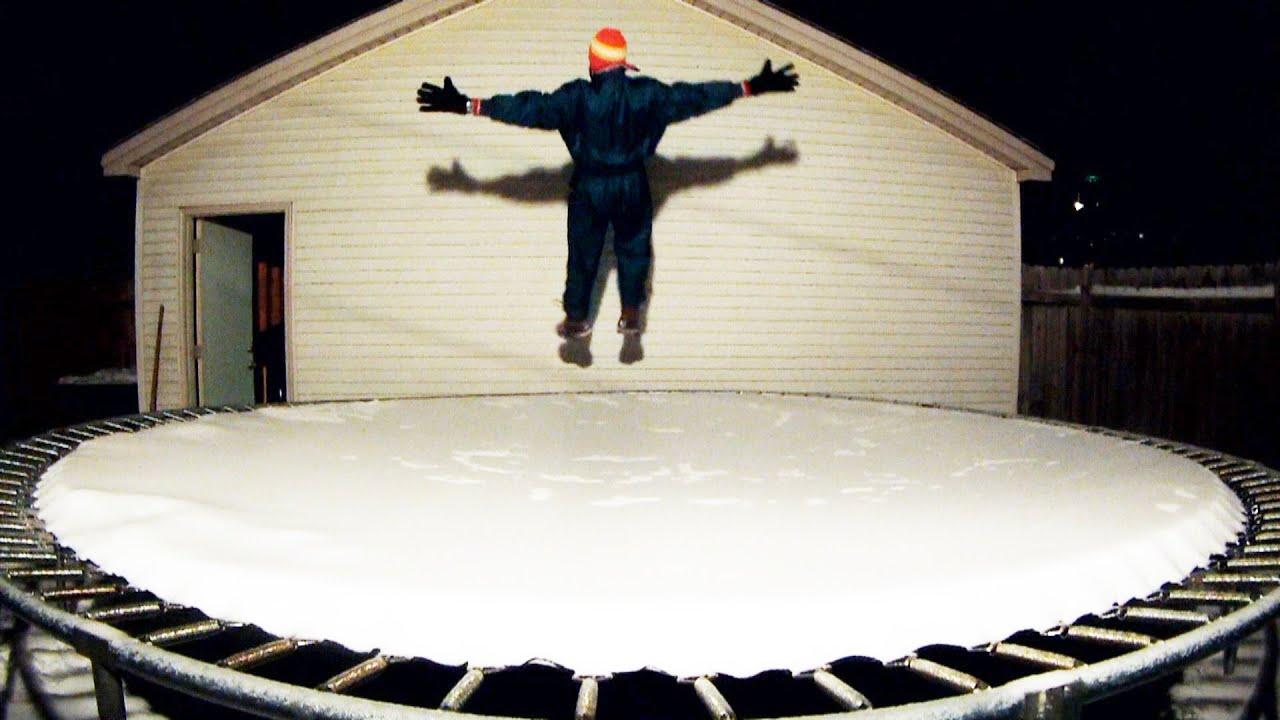Yes, you can play on the trampoline in the winter.
What should you do with a trampoline in the winter?
How to Properly Store a Trampoline in the Winter (Detailed Guide)
- Take off and Store the Protective Net, Jump Mat, and Spring Padding.
- Pack Away the Springs.
- Dissasemble the Frame (If You Have Storage Space)
- Protect the Frame if Left Outside.
- Tie it Down.
- Keep an Eye on It.
Should trampolines be taken down in winter?
You should disassemble your trampoline in the winter if you want to know how to store it and have enough storage space, therefore the answer is definitely yes.
How do I get snow off my trampoline?
One tip for winterizing trampolines is to use a broom rather than a shovel to clear the snow. Your jump pad may be scratched or torn by the metal or plastic shovels’ rough edges. What do you do in a trampoline during a storm? a huge push-style broom.
When there are strong gusts, a trampoline tie-down kit might assist keep it from flying over. Your trampoline is essentially “strapped” to the ground using straps and substantial metal “corkscrew” pegs. Although it’s not necessary to have one there constantly, we urge you to use one when the wind picks up.
A Trampoline Tie-Down Kit is used to help prevent your trampoline from blowing over in high winds. it basically ‘straps’ your trampoline to the ground using straps and large metal ‘corkscrew’ stakes. You don’t need to keep it there all the time, but we strongly recommend using one when the winds pick up.
Wearing shoes on a trampoline is not only risky, but they may also harm the Mat. Due to increased friction, wearing heavy-duty footwear or athletic shoes made for the street might shorten the lifespan of the jumping mat.
Not only is it dangerous to wear shoes on a trampoline, but they can damage the Mat. If you wear heavy-duty shoes or trainers designed for wearing on the street, this can cause the jumping mat to wear out prematurely due to increased friction.
In general, it is thought that trampolines may blow away if the wind speed is more than 40 mph.
In general, if the wind speed is more than 40 mph then it is considered that the trampolines may blow away.
According to studies, having a trampoline on your property makes it more likely that someone will be hurt there. As a result, it raises the possibility that your homes insurance provider will file a liability or medical payments claim against you.
The statistics show that having a trampoline increases the likelihood that someone will be injured on your property. Therefore, it increases your chances of having a liability or medical payments claim by your homeowners insurance company.
To reduce impact energy, the trampoline should ideally be placed on soft ground. The ideal surface is likely bark or something similar since it is supple, absorbs energy, promotes good drainage, and suppresses weeds. Additionally, there is no requirement for underbrush mowing. Avoid walking on rough surfaces like asphalt or concrete.
Ideally the trampoline should be on soft ground to absorb the impact energy. Probably the best surface is bark or similar as this is soft and energy absorbing, will provide good drainage and supress any weeds. There is also no need for grass cutting underneath. You should avoid hard surfaces like concrete or tarmac.
How do you store a big trampoline in the winter?
Hook a plastic trampoline cover to the springs under your trampoline after pulling it over your jump pad. Most sports goods businesses have trampoline coverings. In order to protect your jump pad from snow and rain throughout the winter, trampoline covers are a need.
Pull a plastic trampoline cover over your jump pad, then hook it to the springs underneath your trampoline. You can find trampoline covers at most sporting good stores. Trampoline covers are essential for keeping rain and snow off your jump pad during the winter.
Just bends breaks descends to the earth. Typically, this doesn’t lead to a catastrophic failure, but your trampoline is destroyed. And you are aware that harm is still a possibility.
Just bends breaks goes right down to the ground. Just usually this doesn’t result in a catastrophic fail but it ruins your trampoline. And you know you could you could still definitely get hurt.
Children who jump on trampolines run a significant risk of harm. Injuries to the head and neck as well as sprains and fractures in the arms or legs are possible as a result of the exercise. The American Academy of Pediatrics strongly advises against using trampolines at home due to the significant risk of injury.
Trampoline jumping poses a high risk of injury for children. The activity can result in sprains and fractures in the arms or legs — as well as head and neck injuries. The risk of injury is so high that the American Academy of Pediatrics strongly discourages the use of trampolines at home.
Sandbags are a fundamental and easy technique to add weight to a trampoline. In order to keep the trampoline in place and guarantee that it doesn’t move during storms and strong winds, you essentially only need to lay sandbags on its legs.
A basic and simple way of putting some weight on a trampoline is by using sandbags. You basically just have to place sandbags on the trampoline’s legs to hold it down and ensure it doesn’t move during storms and high winds.
Due to their vast surface area, trampolines are particularly prone to taking off in strong winds. For instance, trampolines can fly into the air and tangle with electricity wires, producing a potentially dangerous situation that might have been avoided with ease.
Because trampolines have a large surface area they are particularly susceptible to flying away in high winds. As an example trampolines can become airborne and become entangled in power lines creating a very dangerous situation that could’ve been easily prevented.
In particular, during the winter months, when the wind might propel a trampoline into the air, RoSPA advised proper trampoline storage. It advised people to “tie down large trampolines; tether kits are available that may be used for this purpose.” Flip smaller trampolines on their sides.
RoSPA said trampolines should be stored safely “particularly during winter months when the wind can force a trampoline to become airborne”. “Tie down large trampolines – there are tether kits available that can be used for this purpose,” it said. “With smaller trampolines, flip them upside down.
Since carbon is utilized in the production process, older, well-worn polypropylene mesh trampoline mats frequently have black residue. The carbon gradually wears through as the mat ages and degrades.
Black residue is a common aspect of an older, well-used polypropylene mesh trampoline mat, since carbon is used in the manufacturing process. As the mat wears over time, the carbon eventually wears through as well.
Does jumping on a trampoline burn more calories than running?
Calorie Burning
You may be surprised to find out that trampoline jumping burns more calories than running.
What should you wear on a trampoline?
Put on tight-fitting t-shirts. You don’t have to worry about holding your top down while leaping if you’re wearing a form-fitting shirt.
- Wear form-fitting t-shirts. With a form-fitting shirt, you don’t have to worry about holding down your top while jumping.
- No skirts or dresses.
The netting helps prevent some of the more serious injuries because it lessens the likelihood of actually falling off the trampoline while jumping, according to Dr. “The netting helps prevent some of the more serious injuries because it does decrease the chances of actually falling off the trampoline while jumping,” he says.
Those nets won’t make a trampoline completely safe, but they do add an extra layer of security that could make all the difference. “The netting helps prevent some of the more serious injuries because it does decrease the chances of actually falling off the trampoline while jumping,” Dr.
Always secure trampolines to the ground before using them. A trampoline moves when you jump on it, and if it isn’t attached, it might endanger others using it or ruin the trampoline. A trampoline that is not anchored can likewise be carried away by strong winds.
Trampolines should always be anchored into the ground before use. Jumping on a trampoline causes it to move, and if it is not anchored, it could damage the trampoline or hurt the people on it. Strong winds can also move or even carry away a trampoline that is not anchored.
For an immediate repair, fasten U-shaped wind stakes over the trampoline’s legs; alternatively, plant auger-style anchors immediately beneath the frame. To ensure your trampoline stays put, even in the harshest weather, hook the provided straps through the augers and tighten them on each side.
Tap U-shaped wind stakes into place over the legs of the trampoline for a quick fix, or sink auger-style anchors into the ground directly below the frame. Hook the included straps through the augers and tighten them down on each side to make sure your trampoline stays put, even during the worst weather.
Is it really necessary to notify your insurance provider if you purchase a trampoline? Absolutely. For a few reasons, you should let your agent know if you have a trampoline. You must first determine if trampolines are genuinely covered or not.
Do you really need to tell your insurance company if you get a trampoline? Absolutely. You’ll want to inform your agent that you have a trampoline for a couple of reasons. First, you’ll need to find out if they actually cover trampolines or not.
Do homeowners policies cover trampolines? A trampoline is sometimes referred to be a “attractive nuisance” by insurers, which implies kids will probably want to use it even when they don’t fully comprehend the hazards. Additionally, it implies that even if a youngster uses your trampoline without your consent and is hurt on it, you might still be held responsible.
Are trampolines covered by home insurance? Many insurers consider a trampoline to be an “attractive nuisance,” which means children will likely try to use it without fully understanding the risks. It also means you may be held liable if a child is injured on your trampoline, even if they use it without your permission.
If a trampoline is set up on a patio or deck, it must also be securely fastened. Your trampoline may be placed on your deck, but you need make sure it is securely fastened to allow your children to jump without risk.
A trampoline must also be properly secured if placed on a patio or deck. While you can put your trampoline on your deck, you should make sure it’s properly secured, so your kids can jump safely.
It is not advised to place a trampoline on concrete. It is hazardous because it has no give and cannot absorb impact energy. A trampoline’s structure might be harmed by a concrete surface, putting users at risk, and making it challenging to secure the trampoline.
Putting a trampoline onto concrete is not recommended. It is dangerous, as it has no give and would not be able to take impact energy. A concrete surface could damage the frame of the trampoline, endanger those jumping on it, and makes it difficult to anchor the trampoline down.
Find a space that is open and level and devoid of any obstacles, such as fences, hedges, trees, laundry lines, or other machinery. Set up the trampoline on an energetically absorbent surface. Sand, bark, or other materials that provide a cushioning effect are good choices.
Yes, you can play on the trampoline in the winter.
